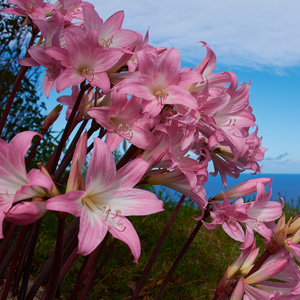Belladonna Lily Growing Guide

What is Belladonna Lily?
Belladonna Lily (Amaryllis belladonna) also known as Naked Ladies are a bulbous perennial. They are part of the Amaryllidaceae family and are native to South Africa. Belladonna Lilies flower before the foliage appears and will begin blooming in late Summer through Autumn. The flowers are trumpet shaped and up to six can form on a single stem. The flowers are produced on a leafless or naked stem and hence the name Naked Lady. The flowers come in different shades of pink and white which is held aloft on a purple or green stem. Belladonna Lilies flower best when they come from clumps that are left undisturbed for several years. In Autumn the foliage will appear and last through Winter until Spring where it will go into dormancy. The foliage is narrow and strappy with a dull green colour. Belladonna Lilies love warm locations so find a position in the garden that gets full sun.
Benefits of Growing Belladonna Lily
Belladonna Lilies are an easy to grow bulb that requires low maintenance. They look great in rock gardens and are excellent for mid or rear position of a border. The bulbs will multiply and form a clump if left to naturalise in the garden. Belladonna Lilies are drought tolerant.
How to Grow Belladonna Lily
Climatic Zones
Suitable for all climates. Able to withstand temperatures down to -5°C.
Plant Size
Height: 60cm, Width: 20-40cm
When To Plant Belladonna Lily
Plant in Spring or Summer.
Soil Preparation
They will grow in most soil types but like well drained soil best. If you have poor soil, dig in decayed organic matter.
How To Plant Belladonna Lily
Plant in full sun, 20-40cm apart with the tip of the bulb above soil level. They like part of the bulb above ground so a little more is better than none.
If using a pot or container, be aware that bulbs can become very large, with individual bulbs needing a 20cm pot.
Belladonna Lily Plant Care
Give regular water during flowering time. Do not water once leaves have died down.
Apply complete plant food after flowering as leaves appear.
Cut flower stalks back once flowering is over. Remove dead foliage when the bulb goes dormant.
Bulbs can be lifted and divided while dormant, but the best flowers come from clumps that have been left undisturbed for several years.
Resistant to most pests. Watch out for snails and slugs.








